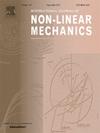The corotational stability postulate: Positive incremental Cauchy stress moduli for diagonal, homogeneous deformations in isotropic nonlinear elasticity
IF 2.8
3区 工程技术
Q2 MECHANICS
International Journal of Non-Linear Mechanics
Pub Date : 2025-02-18
DOI:10.1016/j.ijnonlinmec.2025.105033
引用次数: 0
Abstract
In isotropic nonlinear elasticity the corotational stability postulate (CSP) is the requirement that (0.1)where is any corotational stress rate, is the Cauchy stress and is the Eulerian rate of deformation tensor where is the spatial velocity gradient. For it is equivalent almost everywhere to the monotonicity (TSTS-M) (0.2)For hyperelasticity, (CSP) is in general independent of convexity of the mapping or . Considering a family of diagonal, homogeneous deformations one can, nevertheless, show that (CSP) implies positive incremental Cauchy stress moduli for this deformation family, including the incremental Young’s modulus, the incremental equibiaxial modulus, the incremental planar tension modulus and the incremental bulk modulus. Aside, (CSP) is sufficient for the Baker-Ericksen and tension-extension inequality. Moreover, it implies local invertibility of the Cauchy stress–stretch relation. Together, this shows that (CSP) is a reasonable constitutive stability postulate in nonlinear elasticity, complementing local material stability viz. LH-ellipticity.
旋转稳定性假设:各向同性非线性弹性中对角均匀变形的正增量柯西应力模量
在各向同性非线性弹性中,旋转稳定性假设(CSP)是要求(0.1)< D°Dt[σ],D > >0∀D∈Sym(3)∈{0},其中D°Dt是任意旋转应力率,σ是柯西应力,D =symL是欧拉变形张量的速率,其中L=ḞF−1=Dξv是空间速度梯度。对于σ σ(logV)几乎处处等价于单调性(TSTS-M+) (0.2) < σ σ(logV1)−σ σ(logV2),logV1−logV2 > >0∀V1,V2∈Sym++(3),V1≠V2。对于超弹性,(CSP)一般与映射F∈W(F)或映射U∈Ŵ(U)的凸性无关。然而,对于一类对角均匀变形t∈F(t),我们可以证明(CSP)暗示了该变形族的正增量柯西应力模量,包括增量杨氏模量、增量等双轴模量、增量平面张力模量和增量体积模量。此外,(CSP)对于Baker-Ericksen不等式和张力-扩展不等式是充分的。此外,它还暗示了柯西应力-拉伸关系的局部可逆性。总之,这表明(CSP)是一个合理的非线性弹性本构稳定性假设,补充了材料的局部稳定性,即lh -椭圆性。
本文章由计算机程序翻译,如有差异,请以英文原文为准。
求助全文
约1分钟内获得全文
求助全文
来源期刊
CiteScore
5.50
自引率
9.40%
发文量
192
审稿时长
67 days
期刊介绍:
The International Journal of Non-Linear Mechanics provides a specific medium for dissemination of high-quality research results in the various areas of theoretical, applied, and experimental mechanics of solids, fluids, structures, and systems where the phenomena are inherently non-linear.
The journal brings together original results in non-linear problems in elasticity, plasticity, dynamics, vibrations, wave-propagation, rheology, fluid-structure interaction systems, stability, biomechanics, micro- and nano-structures, materials, metamaterials, and in other diverse areas.
Papers may be analytical, computational or experimental in nature. Treatments of non-linear differential equations wherein solutions and properties of solutions are emphasized but physical aspects are not adequately relevant, will not be considered for possible publication. Both deterministic and stochastic approaches are fostered. Contributions pertaining to both established and emerging fields are encouraged.

 求助内容:
求助内容: 应助结果提醒方式:
应助结果提醒方式:


